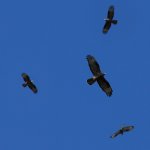luke
A Welsh birder in Dorset!
hi folks,
i am pretty sure i saw and adult honey buzzard this afternoon flying over abergavenny, but not having any real previous experience with this species i just want to run a description by you guys to see what you think
Essentially common buzzard sized with slightly longer wings along with a longish narrow tail. the colour was near white with a destinctive black patch on the 'shoulder' (i only saw the under wing) and a black edge to the wing. a dark band at the end of the tail was noticable but i didnt have any bins but the bird was flying only 100-150 feet up. It also showed an almost extended head. i also watched the bird flying away from me but it was a reasonable distance by now but i noticed it glided on very flat wings flapping slightly quicker than common buzzard in an accipiter type glide, 'flap flap flap -glide'
any thaughts?
i am pretty sure i saw and adult honey buzzard this afternoon flying over abergavenny, but not having any real previous experience with this species i just want to run a description by you guys to see what you think
Essentially common buzzard sized with slightly longer wings along with a longish narrow tail. the colour was near white with a destinctive black patch on the 'shoulder' (i only saw the under wing) and a black edge to the wing. a dark band at the end of the tail was noticable but i didnt have any bins but the bird was flying only 100-150 feet up. It also showed an almost extended head. i also watched the bird flying away from me but it was a reasonable distance by now but i noticed it glided on very flat wings flapping slightly quicker than common buzzard in an accipiter type glide, 'flap flap flap -glide'
any thaughts?





